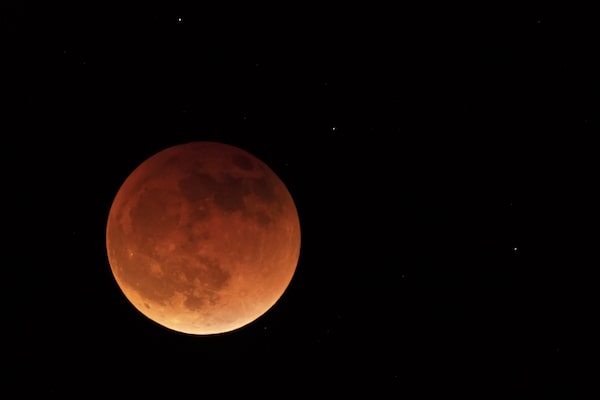
The moon is shown during a full lunar eclipse on May 15, 2022, near Moscow, Idaho, with the reddish color caused by it passing into the shadow of the Earth. Sky watchers across Canada will be treated to another total lunar eclipse on Tuesday.Ted S. Warren/The Associated Press
Halloween may be over but a total lunar eclipse during the early morning hours of Tuesday promises to deliver an eerie spectacle for sky watchers across Canada.
The eclipse marks the second time this year that the moon is set to plunge through Earth’s shadow. Compared with a similar event in May, this eclipse favours viewers in Western Canada, who will have the chance to observe it in its entirety, weather permitting. Those watching in Ontario and points eastward will see the full moon setting at sunrise while the eclipse is still in progress.
It will also mark the last chance to see a total lunar eclipse in Canada until March, 2025.
During a total lunar eclipse, the normally brilliant, white disc of the full moon typically turns coppery orange. The colour shift is the result of sunlight refracted and filtered through Earth’s atmosphere – the only sunlight that can reach the moon while it is fully immersed in shadow.
According to the Observer’s Handbook, a publication of the Royal Astronomical Society of Canada, the eclipse will first become noticeable to those watching around 4:09 a.m. ET or 1:09 a.m. PT when the left limb of the full moon makes contact with the darkest part of Earth’s shadow, known as the umbra. Over the next 1 hour 7 minutes, the moon will slide deeper into darkness until the total eclipse begins at 5:16 a.m. ET or 2:16 a.m. PT.
In places where the moon can still be seen above the horizon, the opposite sequence will unfold when the moon emerges from the umbra starting at 6:42 a.m. ET or 3:42 a.m. PT.
No special equipment or protection is required to observe a lunar eclipse, but a pair of binoculars can enhance the experience.
According to North American folk tradition, the full moon in November is known as the beaver moon.
Meanwhile, lunar activities are in full swing this week at NASA’s Kennedy Space Center in Florida where preparations are under way for the next attempt to launch Artemis I, currently set for Nov. 14. The uncrewed mission will test the giant rocket and capsule system that the space agency has developed to return astronauts to the moon in 2024.

TUESDAY MORNING'S TOTAL LUNAR ECLIPSE:
WHEN TO WATCH
The eclipse will be visible anywhere in the world where the moon is in the sky. Watch for the moon to turn from white to orange once it is completely immersed in the umbra – the darkest part of Earth's shadow.
N
Moon’s path
5
4
3
2
E
W
1
S
1
Partial eclipse ends:
7:49 a.m. ET / 4:49 a.m. PT
2
Total eclipse begins:
5:16 a.m. ET / 2:16 a.m. PT
3
Mid-eclipse:
5:59 a.m. ET / 2:59 a.m. PT
4
Total eclipse ends:
6:42 a.m. ET / 3:42 a.m. PT
5
Partial eclipse ends:
7:49 a.m. ET / 4:49 a.m. PT
TOTAL LUNAR ECLIPSE
Earth blocks sunlight usually reflected by moon, creating partial (penumbra) or total (umbra) shadow.
Moon
Sunlight
Sun
Earth
Umbra
Penumbra
Note: Not to scale
the globe and mail, sources: graphic news;
sky & telescope; NASa; The Old Farmer’s
Almanac

TUESDAY MORNING'S TOTAL LUNAR ECLIPSE:
WHEN TO WATCH
The eclipse will be visible anywhere in the world where the moon is in the sky. Watch for the moon to turn from white to orange once it is completely immersed in the umbra – the darkest part of Earth's shadow.
N
Moon’s path
5
4
3
2
E
W
1
S
1
Partial eclipse begins: 4:09 a.m. ET / 1:09 a.m. PT
2
Total eclipse begins: 5:16 a.m. ET / 2:16 a.m. PT
3
Mid-eclipse: 5:59 a.m. ET / 2:59 a.m. PT
4
Total eclipse ends: 6:42 a.m. ET / 3:42 a.m. PT
5
Partial eclipse ends: 7:49 a.m. ET / 4:49 a.m. PT
TOTAL LUNAR ECLIPSE
Earth blocks sunlight usually reflected by moon, creating partial (penumbra) or total (umbra) shadow.
Moon
Sunlight
Sun
Earth
Umbra
Penumbra
Note: Not to scale
the globe and mail, sources: graphic news;
sky & telescope; NASa; The Old Farmer’s Almanac

TUESDAY MORNING'S TOTAL LUNAR ECLIPSE: WHEN TO WATCH
The eclipse will be visible anywhere in the world where the moon is in the sky. Watch for the moon to turn from white to orange once it is completely immersed in the umbra – the darkest part of Earth's shadow.
N
Partial eclipse begins:
Eastern / Pacific time
4:09 a.m. / 1:09 a.m.
1
Moon’s path
5
2
Total eclipse begins:
5:16 a.m. / 2:16 a.m.
4
3
2
3
Mid-eclipse:
5:59 a.m. / 2:59 a.m.
E
W
1
4
Total eclipse ends:
6:42 a.m. / 3:42 a.m.
Partial eclipse ends:
7:49 a.m. / 4:49 a.m.
5
S
TOTAL LUNAR ECLIPSE
Earth blocks sunlight usually reflected by moon, creating partial (penumbra) or total (umbra) shadow.
Sunlight
Sun
Earth
Moon
Umbra
Penumbra
Note: Not to scale
the globe and mail, sources: graphic news; sky & telescope; NASa; The Old Farmer’s Almanac